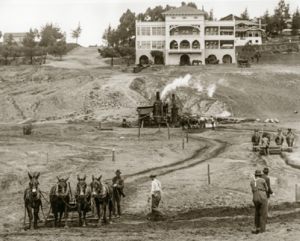Ingleside Terraces, San Francisco facts for kids
Quick facts for kids
Ingleside Terrace
|
|
|---|---|
| Ingleside Terraces | |
 |
|
| Founded by | Joseph A. Leonard |
Ingleside Terraces is a lovely neighborhood in the southwestern part of San Francisco, California. It's a place with about 750 homes, and it was built on the land where the old Ingleside Racetrack used to be.
This neighborhood is close to other areas like Balboa Terrace, Ingleside, Merced Heights, and Lakeside. It's surrounded by Ocean Avenue to the north, Ashton Avenue to the east, Holloway Avenue to the south, and Junipero Serra Boulevard to the west.
One special thing about Ingleside Terraces is the Annual Sundial Park Picnic. During this event, local residents have fun with bicycle, chariot, and wagon races! You can find a very large sundial on Entrada Court. It's surrounded by Urbano Drive, which is an oval-shaped road. This road actually follows the path of the old horse race track! Ingleside Terraces is one of nine special "residence parks" in San Francisco.
Contents
A Look Back: How Ingleside Terraces Began
The land where Ingleside Terraces now stands was once part of a large area called San Miguel Rancho. It was one of the last parts of San Francisco to be developed.
In 1910, a man named Joseph A. Leonard and his company, Urban Realty Improvement Company, bought the old racetrack land. They wanted to turn it into a beautiful neighborhood. By 1912, Ingleside Terraces was officially open! Urbano Drive, which you see today, was paved right on the loop of the old racetrack.
Important Changes Over Time
When Ingleside Terraces was first planned, like many neighborhoods at that time, it had unfair rules. These rules tried to stop people from certain backgrounds, like those of African, Japanese, or Chinese descent, from buying or living in homes there. These kinds of rules were wrong and created unfair situations.
However, things changed! In 1948, a very important court case called Shelley v. Kraemer made these unfair racial restrictions illegal. This meant they could no longer be enforced by law.
In 1957, a brave man named Cecil F. Poole, who was an assistant district attorney, moved into the neighborhood with his family. They were the first non-white residents. Even though the rules were illegal, some people in the neighborhood were still not ready for this change. Sadly, in 1958, a cross was burned on the Pooles' front lawn. This was a very hurtful act. Despite this, the Poole family stayed, and their home, the Cecil F. Poole House, is now a San Francisco Designated Landmark. It reminds us of the important steps taken towards equality.
Community Buildings
In 1922, the Ingleside Presbyterian Church building was finished. Joseph A. Leonard also helped with this project. This church is now recognized as a San Francisco Designated Landmark. Over time, the people who attended the church changed, becoming a more diverse community.
Later, in 1931, the El Rey Theatre opened in Ingleside Terraces. It was designed by a famous architect named Timothy L. Pflueger.
The Exciting Ingleside Racetrack
The Ingleside Racetrack opened on November 28, 1895. It was built after a disagreement between two men, Edward Corrigan and Thomas Williams. Corrigan wanted to build a racetrack that was even bigger and better than Williams's.
On its opening day, eight thousand people came to see the races! The Ingleside Racetrack was very fancy. It had live bands, delicious food, and great views. It was a popular spot for entertainment and even gambling.
Early Automobile Races
Did you know the very first automobile race in California happened at this track in 1900? There were eight cars, but only the winner made it to the finish line! The other cars either crashed or had engine problems. It sounds like quite an adventure!
A Place of Help After the Earthquake
By 1905, Thomas Williams had taken over the racing business in the Bay Area, and the Ingleside Racetrack became part of his collection. However, before the track could reopen, the terrible 1906 earthquake and fires struck San Francisco.
After the earthquake, Williams offered the racetrack to the city for free. It became a safe place for many people who had lost their homes. The horse stables were cleaned, painted, and even had windows added so people could live in them. The track also helped patients from what is now Laguna Honda Hospital while their facility was being repaired. The racetrack never reopened for races after this important time.


